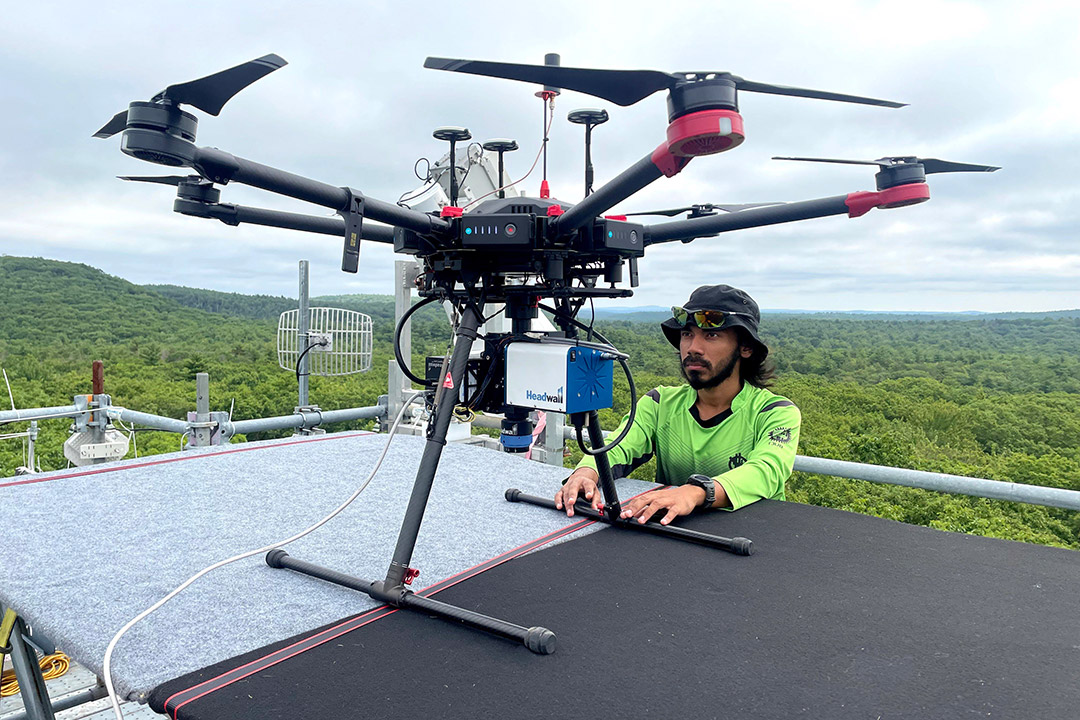Student spotlight: Outside opportunities provide academic growth
Imaging science Ph.D. student Mohammad Saif gained valuable experience by presenting his research to outside audiences
Mohammad Saif
Imaging science Ph.D. student Mohammad Saif prepares a drone for data collection atop a 90-foot tower.
Imaging science Ph.D. student Mohammad Saif earned his bachelor’s degree in electrical and electronic engineering from Bangladesh University of Engineering and Technology in his home country before enrolling at RIT in the fall of 2020. A research project during his undergraduate career drew his attention to imaging, and now he has focused his academic career in remote sensing. Opportunities outside of the lab and the field have helped him learn how to better communicate and discuss the impact of his work.
What made you interested in the imaging science Ph.D. program?
During my final years of undergraduate study, I worked on a project focused on detecting anemia using images of the human eye. This experience sparked my interest in imaging. Later on, a friend I collaborated with on that project began his Ph.D. here and encouraged me to apply here.
What research are you currently working on?
This program introduced me to the vast world of imaging and its diverse applications and processes. I got particularly interested in remote sensing, which deals with analyzing satellite/airborne or drone imagery. Jan van Aardt was leading a project that used drones to predict crop conditions, which immediately piqued my interest. This work not only offered the chance to collect and analyze drone imagery but also the opportunity to contribute to real-world issues of food security and sustainability. Inspired by its potential impact, I joined his group and now I spend my days analyzing table beet imagery.
More specifically, my work involves capturing overhead drone images of table beets using hyperspectral, multispectral, and LiDAR imaging. LiDAR accurately maps the distances of objects, allowing us to generate precise 3D imagery. Multispectral imaging functions like a regular camera but includes additional channels beyond the standard red, green, and blue, capturing red-edge and near-infrared bands as well. Hyperspectral imaging, on the other hand, provides a continuous spectrum of colors, offering detailed insights beyond the limits of human vision.
With this data, we’re able to predict the end-of-season harvest yield and assess disease severity in table beets. I also evaluate the performance of each imaging system, balancing cost with optimal results, which contributes to developing more efficient, precise crop management strategies.
You participated in the Three Minute Thesis competition and presented at the Industrial Associates Symposium. How did these events help you as a Ph.D. student and in your academic career?
I dive deep into the intricate details of my research, focusing on fine-tuning small components and getting fully immersed in the technical aspects. This can sometimes make it easy to lose sight of the bigger picture, as in why I’m doing this work in the first place. Preparing for this kind of event allowed me to take a step back, breathe, and see the larger purpose and impact of my work. This not only helped to communicate effectively with people outside my niche area but also reignited my motivation, giving me fresh perspective and enthusiasm as I returned to my daily work.
Industrial Associates provided me with an opportunity to showcase my work in front of industry professionals. It also gave a platform to engage directly with companies and industry professionals, allowing me to explore the kind of projects they are pursuing and the technical skills they value. It introduced me to potential career paths and connected me with industry professionals.
Overall, I’m incredibly grateful to RIT for providing these kinds of experiences that support growth beyond the lab or the research field. Opportunities like these challenge me to communicate effectively, keep me motivated, and allow me to build connections with the broader academic and professional communities. These events have helped me grow not only as a researcher but also as a professional, preparing me for a future where I can make meaningful contributions to my field.




